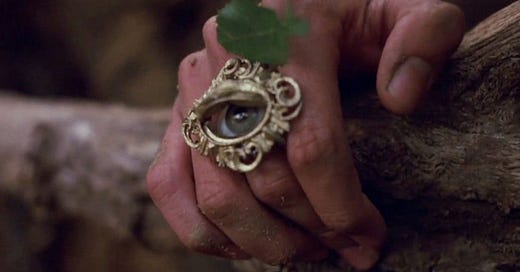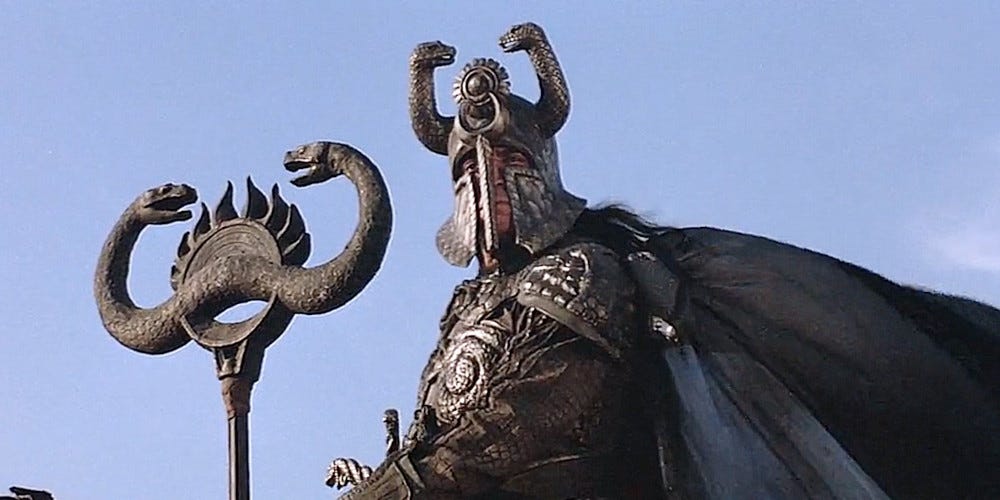Last time, we discussed creating a mysterious stranger in fiction. Now let’s look at using them in TTRPGs.
Compared to fiction, a “mysterious stranger” can be a much harder challenge to introduce around the table. As TTRPG campaigns often progress from encounter to encounter, it’s not always easy for a stranger to arrive with enough notability that they’re then able to simply exit stage right unscathed.
(They will always be pursued by the bears of your player characters.)
But there are ways to help…
Strangers as a Villain
As a GM, if you’re looking to build up a mysterious stranger, you’ll likely need to handle their introduction distant from the reach of combat—or provide quick escape from it—so that they even have a chance to prolong their own mystery. You’ll also need to make them stand out, so that their first, brief glimpse still leaves an impression on players, and compels them to follow up.
That said, it’s not often that potential adversaries are introduced, only to have them escape. Not only do players have effective means of locking them down (whether it’s a simple web spell or an entire prismatic wall), but if an enemy does slip free this can feel extremely frustrating and unrewarding.
(Of course, this can also help boost the players’ motivation to continue after them!)
With that in mind, consider the following when it comes to some mysterious stranger you hope to introduce one session in order to bring back later on:
Introduce them remotely.
A staple of villains everywhere, a more powerful stranger may be first introduced while communicating with their allies via some scrying device (say, The Beastmaster’s memorable eye-ring), through a possessed host, or the like. Your players may notice and covertly listen in, or may even have a brief opportunity to communicate with this stranger themselves, before the lines are closed.Allow the players to learn something, but also provide some means for the stranger to antagonize them as a parting gift in order to help build animosity—a final creature may be summoned, such as a water weird lashing out of the scrying bowl’s waters, or the innocent host may kill themselves at the stranger’s cruel mental commands.
Physically introduce them at a distance.
To help keep them out of direct combat at first, a stranger could arrive at the far edges of the encounter. You might offer clues as to distant movement, shifting shadows, a gleam off some metal. Reward the players’ observation with a glimpse at whoever was trying to arrive unawares. And, what key detail about this stranger stands out—a standard? A symbol, perhaps on a shield?For added drama, consider having the stranger acknowledge their discovery, marking whatever character(s) spotted them.
Introduce groups over individuals.
Hedge your combat bets. Your mystery has a greater chance of survival if carried by more than one stranger.
Plus, if one member of a group of strangers is unavoidably killed during an encounter, that may be a good opportunity to leave clues as to the larger group’s identity or plans. And if an enemy is merely captured, their use of hidden poison or some other “self-destruct” failsafe rather than talk heightens the intrigue.Provide effective means of escape.
Once a stranger engages with the players in some fashion and then needs a quick escape, make sure they have a sufficient item to facilitate this—a potion of gaseous form or flying, a special portal or item of teleportation, etc. Just remember that every aspect of an encounter is often seen as part of an overall strategic puzzle for players to solve; if they see an enemy trying to escape, they will look to stop them. And also, if they see that enemy’s means of escape via an item, they’ll want to capture it for themselves!
(Of course, use of some unique or exotic item may be exactly what helps a stranger stand out and keeps them memorable!)
The Rumored Stranger
Another means to introduce a stranger is indirectly. Rumors, legends, odd mentions in scattered writings or in the margins of a captured spellbook; you can build the mystery of a stranger around the edges of the current storyline with cryptic but repeated references.
Constructing an unseen opponent through reputation alone can help extend their involvement in your campaign without their entering directly into combat. This is also a good opportunity to help flesh out your villain’s place in the story as well.
For example, let’s consider two film killers: Anton Chigurh from No Country for Old Men, and Keyser Söze from The Usual Suspects.
Anton Chigurh is a cold-blooded killer hired to recover stolen drug money and eliminate anyone that gets in his way—including wayward, unsuspecting bystanders. Yet while his actions are certainly thrilling and his portrayal oddly memorable, there’s really nothing about his motivation or character depth that gets revealed. We don’t know what brought him into this dark world, or what drives him through it. We have no idea about his inner dialog, if he even has one. He’s more a force of nature, a literal figure of death than anything else, and about as much of a character as the shark in Jaws.
You might start rumors of a Chigurh-like figure through exploits of his ruthless crimes, but far more memorable is a figure like Keyser Söze from The Usual Suspects.
Keyser Söze’s motives and secret identity are the driving force of the narrative, for the audience to untangle alongside the police (well, U.S. Customs, technically). We learn, eventually, that he is a criminal mastermind bent on revenge for the assault of his family—ruthless enough to kill them himself, and clever enough to hide in plain sight of the Customs agent interrogating him.
Giving the stranger a narrative background to go along with their crimes allows their story to fold into your larger campaign, and not just present another enemy to fight. After all, how might any of the characters’ own backstories fit into the stranger’s as well? Are they on Söze’s hit list for past encounters?
Strangers as a Player Character
A different version of the mysterious stranger can also be one of the player characters themselves. They might be new additions to the group, with secrets and backstories they are not ready to divulge—or must keep secret because it would be too dangerous for themselves or their new allies if they revealed too much.
As we discussed last time, however, it’s important to parse out the mystery over time. Otherwise, the character simply remains one of those professional wrestlers “from parts unknown” (and people stop becoming interested to find out exactly where). A stronger campaign eventually brings the characters’ stories into play, and some of this should help reveal just who this mysterious stranger in their midst really is (with the player’s participation and blessing, of course!).
And by doing so (just as Snake Eyes’ revealed tattoos further connect him with Storm Shadow), new and even more compelling mysteries are often created.
The “Forgotten” Stranger
Finally, there’s also the trope of the mysterious stranger who is also a stranger to themselves. In The Bourne Identity, Jason Bourne needs to first uncover and then grapple with the truth of his own identity. In this case, an assassin cultivated by a shadowy government agency.
Similarly, a warforged character might have damaged “programming” that affects their memory and which they hope to restore—but which may reveal mission parameters they are now uncomfortable with, or advanced capabilities they forgot they had (but which can explain mechanical level gains in a more narrative way).
The effects of powerful spells, artifacts, or reincarnation, even proximity to powerful extraplanar beings might all work to corrupt a character’s memory. A forgotten deal with a powerful fey; memories exchanged for whatever was needed at the time. A mis-brewed potion. The whim of a deity.
Or perhaps the character is really a much more powerful, diabolical being. One who wiped their own memories in order to infiltrate the group beyond any recognition or detection. A sleeper agent… until conditions are right for their reawakening.
Final Thoughts…
My personal favorite mysterious stranger? That would be Disney’s The Phantom Blot. Personally I was always more of a Donald Duck comic fan, but loved reading the Blot’s adventures vs. Mickey Mouse. Voiced in the DuckTales cartoon series by none other than Frank Welker himself.
For more Substack community discussion on No Country for Old Men, visit Art Hits Hard. And for more on The Usual Suspects, you might try The Matterhorn.
And of course, for more memory-fueled plot ideas it’s always worth scouring TV Tropes.








